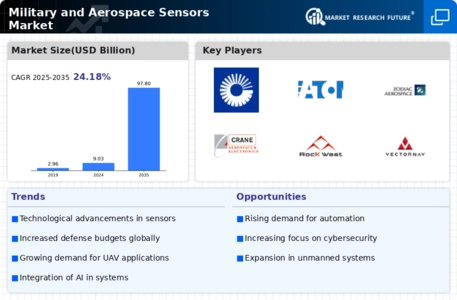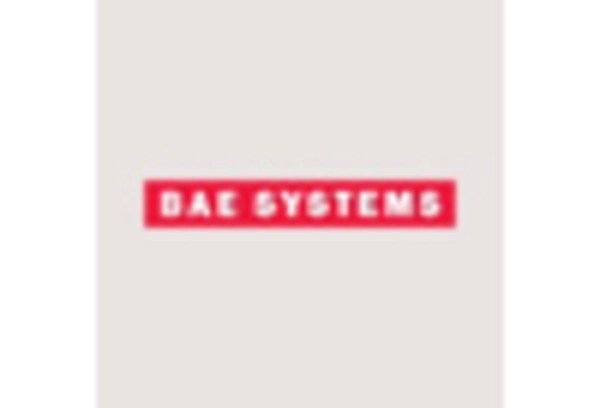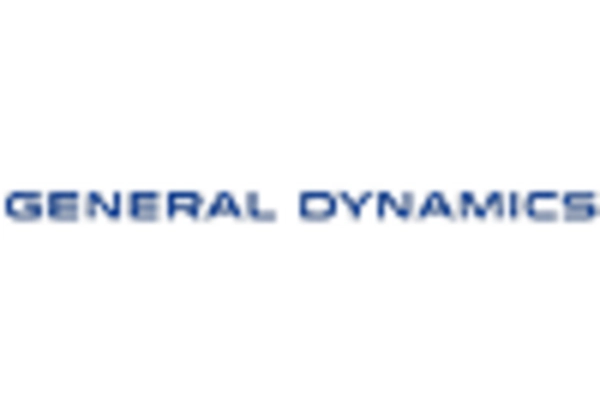-
Executive Summary
-
Market Attractiveness Analysis
- Global Military and Aerospace Sensors Market, by Type
- Global Military and Aerospace Sensors Market, by Platform
- Global Military and Aerospace Sensors Market, by Application
- Global Military and Aerospace Sensors Market, by End Use
- Global Military and Aerospace Sensors Market, by Region
-
Market Introduction
-
Market Definition
-
Scope of the Study
-
Market Structure
-
Key Buying Criteria
-
Market Factor Indicator Analysis
-
Research Methodology
-
Research Process
-
Primary Research
-
Secondary Research
-
Market Size Estimation
-
Forecast Model
-
List of Assumptions
-
Market Insights
-
Market Dynamics
-
Introduction
-
Drivers
- Ongoing advancements in sensor technology
- Increasing demand for new aircraft across the globe
- Drivers Impact Analysis
-
Restraints
- Restricted defense budgets
- Restraint Impact Analysis
-
Opportunities
- Increasing adoption of the internet of things in the aviation industry
-
Market/Technological Trends
-
Patent Trends
-
Regulatory Landscape/Standards
-
Market Factor Analysis
-
Value Chain/Supply Chain Analysis
- R&D
- Manufacturing
- Distribution & Sales
- Post-Sales Monitoring
-
Porter’s Five Forces Analysis
- Threat of New Entrants
- Bargaining Power of Buyers
- Threat of Substitutes
- Segment Rivalry
- Bargaining Power of Suppliers
-
Global Military and Aerospace Sensors Market, by Type
-
Introduction
-
Pressure Sensors
-
Temperature Sensors
-
Torque Sensors
-
Speed Sensors
-
Accelerometers
-
Level Sensors
-
Flow Sensors
-
Proximity Sensors
-
Gyroscopes
-
Radar Sensors
-
Magnetic Sensors
-
Others
-
Global Military and Aerospace Sensors Market, by Platform
-
Introduction
-
Airborne
-
Land
-
Naval
-
Space
-
Global Military and Aerospace Sensors Market, by Application
-
Introduction
-
Intelligence & Reconnaissance
-
Communication & Navigation
-
Combat Operations
-
Electronic Warfare
-
Target Recognition
-
Command and Control
-
Surveillance & Monitoring
-
Global Military and Aerospace Sensors Market, by End Use
-
Introduction
-
OEM
-
Aftermarket
-
Global Military and Aerospace Sensors Market, by Region
-
Introduction
-
North America
- US
- Canada
-
Europe
- UK
- Germany
- France
- Italy
- Rest of Europe
-
Asia-Pacific
- China
- Japan
- India
- Australia
- Rest of Asia-Pacific
-
Middle East & Africa
- Saudi Arabia
- UAE
- Rest of the Middle East & Africa
-
Latin America
- Brazil
- Rest of Latin America
-
Competitive Landscape
-
Competitive Overview
-
Competitor Dashboard
-
Major Growth Key Strategies in the Global Military and Aerospace Sensors Market
-
Competitive Benchmarking
-
Market Share Analysis
-
Leading Player in terms of the Number of Developments in the Global Military and Aerospace Sensors Market
-
Key Developments & Growth Strategies
- New Product Launch/Service Platform
- Merger & Acquisition
- Joint Ventures
-
Company Profiles
-
Key Market Players
- Honeywell International Inc.
- Ametek, Inc.
- Thales Group
- TE Connectivity Ltd.
- Raytheon Company
- Lockheed Martin Corporation
- Safran Electronics & Defense
- BAE Systems PLC
- General Electric Company
- Ultra-Electronics
-
(Company overview, financial updates, products & service offered, key developments, SWOT analysis, and key strategies to be provided for all the listed companies)
-
Key Market Players
- UTC Aerospace Systems
- Meggitt PLC
- Kongsberg Gruppen
- Crane Aerospace
- Eaton Corporation
- Zodiac Aerospace
- Viooa Imaging Technology
- Rockwest Solutions
- Microflown Avisa B.V.
- Vectornav Technologies, LLC
-
Appendix
-
References
-
Related Reports
-
List of Abbreviation
-
List of Tables
-
LIST OF ASSUMPTIONS
-
MAJOR PATENTS GRANTED FOR MILITARY AND AEROSPACE SENSORS (2024-2032)
-
TYPE: GLOBAL MILITARY AND AEROSPACE SENSORS MARKET, 2024-2032 (USD MILLION)
-
PLATFORM: GLOBAL MILITARY AND AEROSPACE SENSORS MARKET, 2024-2032 (USD MILLION)
-
APPLICATION: GLOBAL MILITARY AND AEROSPACE SENSORS MARKET, 2024-2032 (USD MILLION)
-
END USE: GLOBAL MILITARY AND AEROSPACE SENSORS MARKET, 2024-2032 (USD MILLION)
-
GLOBAL MILITARY AND AEROSPACE SENSORS MARKET, BY REGION, 2024-2032 (USD MILLION)
-
NORTH AMERICA: MILITARY AND AEROSPACE SENSORS MARKET, BY COUNTRY, 2024-2032 (USD MILLION)
-
NORTH AMERICA: MILITARY AND AEROSPACE SENSORS MARKET, BY TYPE, 2024-2032 (USD MILLION)
-
NORTH AMERICA: MILITARY AND AEROSPACE SENSORS MARKET, BY PLATFORM, 2024-2032 (USD MILLION)
-
NORTH AMERICA: MILITARY AND AEROSPACE SENSORS MARKET, BY APPLICATION, 2024-2032 (USD MILLION)
-
NORTH AMERICA: MILITARY AND AEROSPACE SENSORS MARKET, BY END USE, 2024-2032 (USD MILLION)
-
US: MILITARY AND AEROSPACE SENSORS MARKET, BY TYPE, 2024-2032 (USD MILLION)
-
US: MILITARY AND AEROSPACE SENSORS MARKET, BY PLATFORM, 2024-2032 (USD MILLION)
-
US: MILITARY AND AEROSPACE SENSORS MARKET, BY APPLICATION, 2024-2032 (USD MILLION)
-
US: MILITARY AND AEROSPACE SENSORS MARKET, BY END USE, 2024-2032 (USD MILLION)
-
CANADA: MILITARY AND AEROSPACE SENSORS MARKET, BY TYPE, 2024-2032 (USD MILLION)
-
CANADA: MILITARY AND AEROSPACE SENSORS MARKET, BY PLATFORM, 2024-2032 (USD MILLION)
-
CANADA: MILITARY AND AEROSPACE SENSORS MARKET, BY APPLICATION, 2024-2032 (USD MILLION)
-
CANADA: MILITARY AND AEROSPACE SENSORS MARKET, BY END USE, 2024-2032 (USD MILLION)
-
EUROPE: MILITARY AND AEROSPACE SENSORS MARKET, BY COUNTRY, 2024-2032 (USD MILLION)
-
EUROPE: MILITARY AND AEROSPACE SENSORS MARKET, BY TYPE, 2024-2032 (USD MILLION)
-
EUROPE: MILITARY AND AEROSPACE SENSORS MARKET, BY PLATFORM, 2024-2032 (USD MILLION)
-
EUROPE: MILITARY AND AEROSPACE SENSORS MARKET, BY APPLICATION, 2024-2032 (USD MILLION)
-
EUROPE: MILITARY AND AEROSPACE SENSORS MARKET, BY END USE, 2024-2032 (USD MILLION)
-
UK: MILITARY AND AEROSPACE SENSORS MARKET, BY TYPE, 2024-2032 (USD MILLION)
-
UK: MILITARY AND AEROSPACE SENSORS MARKET, BY PLATFORM, 2024-2032 (USD MILLION)
-
UK: MILITARY AND AEROSPACE SENSORS MARKET, BY APPLICATION, 2024-2032 (USD MILLION)
-
UK: MILITARY AND AEROSPACE SENSORS MARKET, BY END USE, 2024-2032 (USD MILLION)
-
GERMANY: MILITARY AND AEROSPACE SENSORS MARKET, BY TYPE, 2024-2032 (USD MILLION)
-
GERMANY: MILITARY AND AEROSPACE SENSORS MARKET, BY PLATFORM, 2024-2032 (USD MILLION)
-
GERMANY: MILITARY AND AEROSPACE SENSORS MARKET, BY APPLICATION, 2024-2032 (USD MILLION)
-
GERMANY: MILITARY AND AEROSPACE SENSORS MARKET, BY END USE, 2024-2032 (USD MILLION)
-
FRANCE: MILITARY AND AEROSPACE SENSORS MARKET, BY TYPE, 2024-2032 (USD MILLION)
-
FRANCE: MILITARY AND AEROSPACE SENSORS MARKET, BY PLATFORM, 2024-2032 (USD MILLION)
-
FRANCE: MILITARY AND AEROSPACE SENSORS MARKET, BY APPLICATION, 2024-2032 (USD MILLION)
-
FRANCE: MILITARY AND AEROSPACE SENSORS MARKET, BY END USE, 2024-2032 (USD MILLION)
-
ITALY: MILITARY AND AEROSPACE SENSORS MARKET, BY TYPE, 2024-2032 (USD MILLION)
-
ITALY: MILITARY AND AEROSPACE SENSORS MARKET, BY PLATFORM, 2024-2032 (USD MILLION)
-
ITALY: MILITARY AND AEROSPACE SENSORS MARKET, BY APPLICATION, 2024-2032 (USD MILLION)
-
ITALY: MILITARY AND AEROSPACE SENSORS MARKET, BY END USE, 2024-2032 (USD MILLION)
-
REST OF EUROPE: MILITARY AND AEROSPACE SENSORS MARKET, BY TYPE, 2024-2032 (USD MILLION)
-
REST OF EUROPE: MILITARY AND AEROSPACE SENSORS MARKET, BY PLATFORM, 2024-2032 (USD MILLION)
-
REST OF EUROPE: MILITARY AND AEROSPACE SENSORS MARKET, BY APPLICATION, 2024-2032 (USD MILLION)
-
REST OF EUROPE: MILITARY AND AEROSPACE SENSORS MARKET, BY END USE, 2024-2032 (USD MILLION)
-
ASIA-PACIFIC: MILITARY AND AEROSPACE SENSORS MARKET, BY COUNTRY, 2024-2032 (USD MILLION)
-
ASIA-PACIFIC: MILITARY AND AEROSPACE SENSORS MARKET, BY TYPE, 2024-2032 (USD MILLION)
-
ASIA-PACIFIC: MILITARY AND AEROSPACE SENSORS MARKET, BY PLATFORM, 2024-2032 (USD MILLION)
-
ASIA-PACIFIC: MILITARY AND AEROSPACE SENSORS MARKET, BY APPLICATION, 2024-2032 (USD MILLION)
-
ASIA-PACIFIC: MILITARY AND AEROSPACE SENSORS MARKET, BY END USE, 2024-2032 (USD MILLION)
-
CHINA: MILITARY AND AEROSPACE SENSORS MARKET, BY TYPE, 2024-2032 (USD MILLION)
-
CHINA: MILITARY AND AEROSPACE SENSORS MARKET, BY PLATFORM, 2024-2032 (USD MILLION)
-
CHINA: MILITARY AND AEROSPACE SENSORS MARKET, BY APPLICATION, 2024-2032 (USD MILLION)
-
CHINA: MILITARY AND AEROSPACE SENSORS MARKET, BY END USE, 2024-2032 (USD MILLION)
-
INDIA: MILITARY AND AEROSPACE SENSORS MARKET, BY TYPE, 2024-2032 (USD MILLION)
-
INDIA: MILITARY AND AEROSPACE SENSORS MARKET, BY PLATFORM, 2024-2032 (USD MILLION)
-
INDIA: MILITARY AND AEROSPACE SENSORS MARKET, BY APPLICATION, 2024-2032 (USD MILLION)
-
INDIA: MILITARY AND AEROSPACE SENSORS MARKET, BY END USE, 2024-2032 (USD MILLION)
-
JAPAN: MILITARY AND AEROSPACE SENSORS MARKET, BY TYPE, 2024-2032 (USD MILLION)
-
JAPAN: MILITARY AND AEROSPACE SENSORS MARKET, BY PLATFORM, 2024-2032 (USD MILLION)
-
JAPAN: MILITARY AND AEROSPACE SENSORS MARKET, BY APPLICATION, 2024-2032 (USD MILLION)
-
JAPAN: MILITARY AND AEROSPACE SENSORS MARKET, BY END USE, 2024-2032 (USD MILLION)
-
AUSTRALIA: MILITARY AND AEROSPACE SENSORS MARKET, BY TYPE, 2024-2032 (USD MILLION)
-
AUSTRALIA: MILITARY AND AEROSPACE SENSORS MARKET, BY PLATFORM, 2024-2032 (USD MILLION)
-
AUSTRALIA: MILITARY AND AEROSPACE SENSORS MARKET, BY APPLICATION, 2024-2032 (USD MILLION)
-
AUSTRALIA: MILITARY AND AEROSPACE SENSORS MARKET, BY END USE, 2024-2032 (USD MILLION)
-
REST OF ASIA-PACIFIC: MILITARY AND AEROSPACE SENSORS MARKET, BY TYPE, 2024-2032 (USD MILLION)
-
REST OF ASIA-PACIFIC: MILITARY AND AEROSPACE SENSORS MARKET, BY PLATFORM, 2024-2032 (USD MILLION)
-
REST OF ASIA-PACIFIC: MILITARY AND AEROSPACE SENSORS MARKET, BY APPLICATION, 2024-2032 (USD MILLION)
-
REST OF ASIA-PACIFIC: MILITARY AND AEROSPACE SENSORS MARKET, BY END USE, 2024-2032 (USD MILLION)
-
MIDDLE EAST & AFRICA: MILITARY AND AEROSPACE SENSORS MARKET, BY COUNTRY, 2024-2032 (USD MILLION)
-
MIDDLE EAST & AFRICA: MILITARY AND AEROSPACE SENSORS MARKET, BY TYPE, 2024-2032 (USD MILLION)
-
MIDDLE EAST & AFRICA: MILITARY AND AEROSPACE SENSORS MARKET, BY PLATFORM, 2024-2032 (USD MILLION)
-
MIDDLE EAST & AFRICA: MILITARY AND AEROSPACE SENSORS MARKET, BY APPLICATION, 2024-2032 (USD MILLION)
-
MIDDLE EAST & AFRICA: MILITARY AND AEROSPACE SENSORS MARKET, BY END USE, 2024-2032 (USD MILLION)
-
SAUDI ARABIA: MILITARY AND AEROSPACE SENSORS MARKET, BY TYPE, 2024-2032 (USD MILLION)
-
SAUDI ARABIA: MILITARY AND AEROSPACE SENSORS MARKET, BY PLATFORM, 2024-2032 (USD MILLION)
-
SAUDI ARABIA: MILITARY AND AEROSPACE SENSORS MARKET, BY APPLICATION, 2024-2032 (USD MILLION)
-
SAUDI ARABIA: MILITARY AND AEROSPACE SENSORS MARKET, BY END USE, 2024-2032 (USD MILLION)
-
UAE: MILITARY AND AEROSPACE SENSORS MARKET, BY TYPE, 2024-2032 (USD MILLION)
-
UAE: MILITARY AND AEROSPACE SENSORS MARKET, BY PLATFORM, 2024-2032 (USD MILLION)
-
UAE: MILITARY AND AEROSPACE SENSORS MARKET, BY APPLICATION, 2024-2032 (USD MILLION)
-
UAE: MILITARY AND AEROSPACE SENSORS MARKET, BY END USE, 2024-2032 (USD MILLION)
-
REST OF THE MIDDLE EAST & AFRICA: MILITARY AND AEROSPACE SENSORS MARKET, BY TYPE, 2024-2032 (USD MILLION)
-
REST OF THE MIDDLE EAST & AFRICA: MILITARY AND AEROSPACE SENSORS MARKET, BY PLATFORM, 2024-2032 (USD MILLION)
-
REST OF THE MIDDLE EAST & AFRICA: MILITARY AND AEROSPACE SENSORS MARKET, BY APPLICATION, 2024-2032 (USD MILLION)
-
REST OF THE MIDDLE EAST & AFRICA: MILITARY AND AEROSPACE SENSORS MARKET, BY END USE, 2024-2032 (USD MILLION)
-
LATIN AMERICA: MILITARY AND AEROSPACE SENSORS MARKET, BY COUNTRY, 2024-2032 (USD MILLION)
-
LATIN AMERICA: MILITARY AND AEROSPACE SENSORS MARKET, BY TYPE, 2024-2032 (USD MILLION)
-
LATIN AMERICA: MILITARY AND AEROSPACE SENSORS MARKET, BY PLATFORM, 2024-2032 (USD MILLION)
-
LATIN AMERICA: MILITARY AND AEROSPACE SENSORS MARKET, BY APPLICATION, 2024-2032 (USD MILLION)
-
LATIN AMERICA: MILITARY AND AEROSPACE SENSORS MARKET, BY END USE, 2024-2032 (USD MILLION)
-
BRAZIL: MILITARY AND AEROSPACE SENSORS MARKET, BY TYPE, 2024-2032 (USD MILLION)
-
BRAZIL: MILITARY AND AEROSPACE SENSORS MARKET, BY PLATFORM, 2024-2032 (USD MILLION)
-
BRAZIL: MILITARY AND AEROSPACE SENSORS MARKET, BY APPLICATION, 2024-2032 (USD MILLION)
-
BRAZIL: MILITARY AND AEROSPACE SENSORS MARKET, BY END USE, 2024-2032 (USD MILLION)
-
REST OF LATIN AMERICA: MILITARY AND AEROSPACE SENSORS MARKET, BY TYPE, 2024-2032 (USD MILLION)
-
REST OF LATIN AMERICA: MILITARY AND AEROSPACE SENSORS MARKET, BY PLATFORM, 2024-2032 (USD MILLION)
-
REST OF LATIN AMERICA: MILITARY AND AEROSPACE SENSORS MARKET, BY APPLICATION, 2024-2032 (USD MILLION)
-
REST OF LATIN AMERICA: MILITARY AND AEROSPACE SENSORS MARKET, BY END USE, 2024-2032 (USD MILLION)
-
THE MOST ACTIVE PLAYERS IN THE GLOBAL MILITARY AND AEROSPACE SENSORS MARKET
-
CONTRACTS AND AGREEMENTS
-
MERGERS AND ACQUISITIONS
-
PRODUCT DEVELOPMENTS
-
EXPANSIONS AND INVESTMENTS
-
JOINT VENTURES AND PARTNERSHIPS
-
-
List of Figures
-
MARKET SYNOPSIS
-
GLOBAL MILITARY AND AEROSPACE SENSORS MARKET: MARKET ATTRACTIVENESS ANALYSIS
-
GLOBAL MILITARY AND AEROSPACE SENSORS MARKET ANALYSIS, BY TYPE
-
GLOBAL MILITARY AND AEROSPACE SENSORS MARKET ANALYSIS, BY END USE
-
GLOBAL MILITARY AND AEROSPACE SENSORS MARKET ANALYSIS, BY APPLICATION
-
GLOBAL MILITARY AND AEROSPACE SENSORS MARKET ANALYSIS, BY END USE
-
GLOBAL MILITARY AND AEROSPACE SENSORS MARKET ANALYSIS, BY REGION
-
GLOBAL MILITARY AND AEROSPACE SENSORS MARKET: MARKET STRUCTURE
-
KEY BUYING CRITERIA FOR MILITARY AND AEROSPACE SENSORS TYPES
-
RESEARCH PROCESS OF MRFR
-
NORTH AMERICA: MARKET SIZE & MARKET SHARE, BY COUNTRY, 2024 VS 2032
-
EUROPE: MARKET SIZE & MARKET SHARE, BY COUNTRY, 2024 VS 2032
-
ASIA-PACIFIC: MARKET SIZE & MARKET SHARE, BY COUNTRY, 2024 VS 2032
-
MIDDLE EAST & AFRICA: MARKET SIZE & MARKET SHARE, BY COUNTRY, 2024 VS 2032
-
LATIN AMERICA: MARKET SIZE & MARKET SHARE, BY REGION, 2024 VS 2032
-
MARKET DYNAMICS OVERVIEW
-
DRIVERS IMPACT ANALYSIS: GLOBAL MILITARY AND AEROSPACE SENSORS MARKET
-
RESTRAINTS IMPACT ANALYSIS: GLOBAL MILITARY AND AEROSPACE SENSORS MARKET
-
PORTER’S FIVE FORCES ANALYSIS OF THE GLOBAL MILITARY AND AEROSPACE SENSORS MARKET
-
SUPPLY CHAIN: GLOBAL MILITARY AND AEROSPACE SENSORS MARKET
-
GLOBAL MILITARY AND AEROSPACE SENSORS MARKET SHARE, BY TYPE, 2024 (% SHARE)
-
GLOBAL MILITARY AND AEROSPACE SENSORS MARKET SHARE, BY END USE, 2024 (% SHARE)
-
GLOBAL MILITARY AND AEROSPACE SENSORS MARKET SHARE, BY APPLICATION, 2024 (% SHARE)
-
GLOBAL MILITARY AND AEROSPACE SENSORS MARKET SHARE, BY REGION, 2024 (% SHARE)
-
NORTH AMERICA: MILITARY AND AEROSPACE SENSORS MARKET SHARE, BY COUNTRY, 2024 (% SHARE)
-
EUROPE: MILITARY AND AEROSPACE SENSORS MARKET SHARE, BY COUNTRY, 2024 (% SHARE)
-
ASIA-PACIFIC: MILITARY AND AEROSPACE SENSORS MARKET SHARE, BY COUNTRY, 2024 (% SHARE)
-
MIDDLE EAST & AFRICA: MILITARY AND AEROSPACE SENSORS MARKET SHARE, BY COUNTRY, 2024 (% SHARE)
-
LATIN AMERICA: MILITARY AND AEROSPACE SENSORS MARKET SHARE, BY COUNTRY, 2024 (% SHARE)
-
COMPETITOR DASHBOARD: GLOBAL MILITARY AND AEROSPACE SENSORS MARKET
-
CAPITAL MARKET RATIO AND FINANCIAL MATRIX
-
CONTRACTS & AGREEMENTS: THE MAJOR STRATEGY ADOPTED BY KEY PLAYERS IN THE GLOBAL MILITARY AND AEROSPACE SENSORS MARKET
-
BENCHMARKING OF MAJOR COMPETITORS
-
MAJOR MANUFACTURERS MARKET SHARE ANALYSIS, 2024
-
"

















Leave a Comment